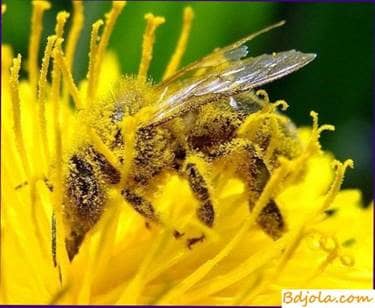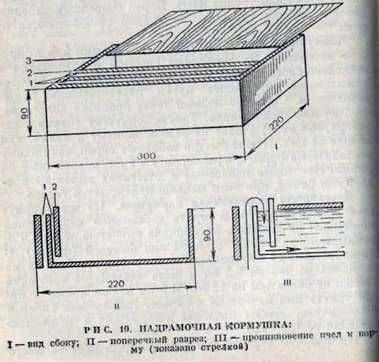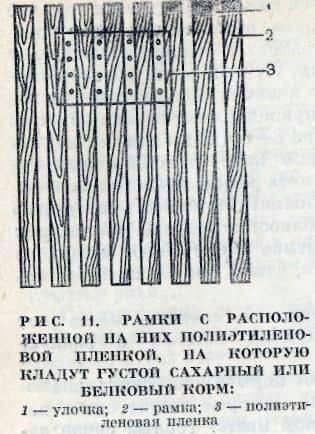Feed for bees, cooked using sugar

Bees, like many animals, are more productive when they are fully fed. The natural and best food for bees is honey. However, in greenhouses, often because of the lack of a sufficient number of honey plants, it is necessary to replenish fodder stocks of bees at the expense of granulated sugar. This usually happens when the area is overcrowded with bees or the scarcity of the surrounding forage reserve, as well as when the strength of bee colonies is weakened. To feed sugar is resorted and in those cases when it is required to replace the pade honey available in the nests. In apiaries where individual families are sick with foulbrood, feeding bees to sugar syrup prevents the possibility of re-beating honey bee colonies of honey bee colonies.
Feed reserves for the spring development of hothouse bee colonies should be harvested for future use from the honey of the last year collected during the period of significant or major honey gathering.
When the bees are forced to feed sugar, the best concentration of syrup will be dissolving 1.5 kg of sugar in 1 liter of water. To prepare the syrup, especially if the food goes into winter, use only soft water. Well water is boiled and only after sludge (water carefully drained) is used for these purposes.
Prepare the syrup in an enamel or tinned saucepan. A measured amount of water is brought to a boil and with a low heat, gradually, in several steps, with careful stirring dissolve the required amount of granulated sugar. It is important that the sugar does not burn during the preparation of the syrup.
Overheated sugar at a temperature above 160 њ C caramelizes – turns into complex compounds of dark color with a specific taste. Such a food for bees will be more harmful than pade honey. Therefore, you can not pre-fill the sugar, and then bring the solution to a boil. As soon as the sand has dissolved and there are signs of the beginning
Beet and sugar cane for bee nutrition is equivalent. However, cane sugar tastes less sweet. It contains more glucose, prone to crystallization, so when the choice of granulated sugar is given preference to beet. Yellow raw sugar contains many minerals and is unsuitable for feeding bees.
To save money for feeding bees sometimes use sugar crumbs, sugar tags, confectionery waste, etc. However, before you buy them, you need to make sure that they do not contain impurities harmful to bees. Sugar sand with a small content of table salt, soda and other impurities should be fed in summer, without a period of time, since during this period the harm from them to bees will be less tangible than in winter.
Sugar sand, stored in a damp room and losing flowability, it is necessary to boil for 10 minutes to kill the microflora harmful to bees.
It is not customary to use the sugar waste of confectionery shops and factories in food for bees. They may contain admixtures of starch, flour and other substances not digested by bees that cause the crystallization of honey.
Feed sugar beet syrup in three ways: using feeders, which are pre-installed in the hives; by filling the honeycombs with syrup and then rearranging these cells into nests; the general feeding of bees, when a trough or a large container with a syrup is installed on the apiary, from which, in the daytime, the bees are amicably transferred to their nests.
Feeding bees in feeders and honeycombs spend at night.
Feeders at the same time use different shapes and capacities.
Feeders-frames are made of wooden bars and plywood. The width and height of such feeders can be different. To the feeder does not swell and does not leak, it is oiled, then at the seams at the seams treated with a mixture of wax and rosin. The feeder has the advantage that it serves as a diaphragm and can be easily insulated from above. At the same time, the feeder has significant drawbacks. For the feeding of bee colonies occupying a full nest, frames are temporarily removed from it, besides in a cold time the syrup in such feeders quickly cools and the bees cease to take it because of the cold. Deep feeders are difficult to wash. Before the next filling of the feeder with syrup, they are difficult to get rid of the bees.
Feeding cans can be glass or other material. They are filled with syrup and wrapped in several layers of cloth or gauze. The number of necessary layers is determined by turning the can upside down.
Syrup should not flow; having saturated the canvas, it is held in a jar. Such a feeder (the bank in an inverted form) is placed on the frames occupied by bees, or near them. Bees quickly take the syrup if the jar is put on brusochki size 1×1 cm, placed on the frame. Some beekeepers in the canvas cut out the lumen for the can, while the nest is cooled down less.
Wooden overhead frame. Of all feeders, preference should be given to the wooden over-frame feeder. It is made in the form of a box with a capacity of 2 to 5 liters, closed with glass or plywood on top (better). In the box, insert the inner wall so that it does not reach the bottom by 0.5 cm and was removed from the outer wall by no more than 12 mm. In this case, the bees will not sink or get dirty in syrup. Taking all the syrup in the corridor, the bees pass into the feeding bowl and completely drain it.

Before placing the feeder, determine its place above the frames, taking into account that the syrup from below is heated by bees. 3-4 cm across the frames are wrapped in a canvas. Then put the feeder so that the bees from under the canvas freely passed into its corridor. The feeder is given a slight inclination towards the passage of the bees and is filled with syrup. To avoid splashing, the syrup is poured with a small jet, as the feeder is filled, the jet is strengthened. To the bees quickly found the syrup, several drops of it drip into the bee pass of the feeder and the shoulders of the frames in the hive. After that, the feeder is closed, insulated with a superframe cushion and the lid of the hive is closed.
Feeding the syrup in honeycombs is preferable when the bees are healthy, and for the winter they are not provided with enough food and there is no way to give them honey. Stuffed syrup frames set to the edge of the nest. Usually this is done in extreme cases, since this method is laborious, and the surplus syrup that flows from the framework creates unsanitary conditions.
Filling syrup cells of honeycombs is complicated by the fact that the air in the cells forms syrup plugs. In order for the syrup to completely fill the cells, the honeycomb is laid flat over the trough. With a streamer, the cells are filled with a thin stream through a strainer. When filling the reverse side of the honeycomb, slightly raise the upper bar. Stuffed with syrup honeycomb for 2-3 hours, hang over a trough or tray in the beehive housing to cover excess syrup. You can fill the frames by placing them in a standing bowl, and gradually fill this container with the syrup from the hose. All cells will be completely filled, as they are filled with syrup gradually and force out air from the cells. The cargo is placed on the frame so that it does not go up.
General feeding is used in apiaries when there are no contagious diseases on neighboring apiaries within a radius of 3 km.
For feeding use troughs or specially made Boxes-feeders , which are placed near the apiary in a sunny, windless place. Warm syrup is poured into the troughs so that it is enough for the whole day. If the feed is small, then in order to avoid bee larceny feed it to the end of the day. So that the bees in the syrup are not drowned, its surface is covered with wood or straw planks.
General feeding of bees with some economy of labor and time has significant drawbacks. Separate bee colonies can add as much syrup as there is no room for laying eggs by the uterus, and other families will not be provided with food due to weak strength or passivity. In such cases, a general inspection of bee colonies and the distribution of fodder stocks are necessary.
In the early spring, when it is still cold, and bees can not take food from feeders, dense fodder – Kandi is fed to stimulate family growth, as well as saving bees from hunger in winter . For its preparation take 8 kg of powdered sugar, which can be obtained by grinding granulated sugar on a micromilk, 1.75 kg of honey and 0.25 liters of water. All this is thoroughly mixed. If honey crystallized, it is melted in a water bath at a temperature of no higher than 60-65 њ C.
A water bath is a pot of heated water placed on a stove, into which a second pot of honey is hung.
Each family is given 1 to 1.5 kg of candy in the form of flat cakes on frames, which are surrounded by bees. To ensure that the food does not stain the frame and does not fall to the bottom, it is put on film, on which holes are made over the streets for access to bees.

In some countries of Western Europe, dry sugar is used as a feed for bees. The bees dissolve it with their saliva, use it for nutrition and put them in cells. Specially set experiments in our country found that feeding bees with dry sugar depletes bees reduces the duration of their life.
Feed for bees, cooked using sugar
